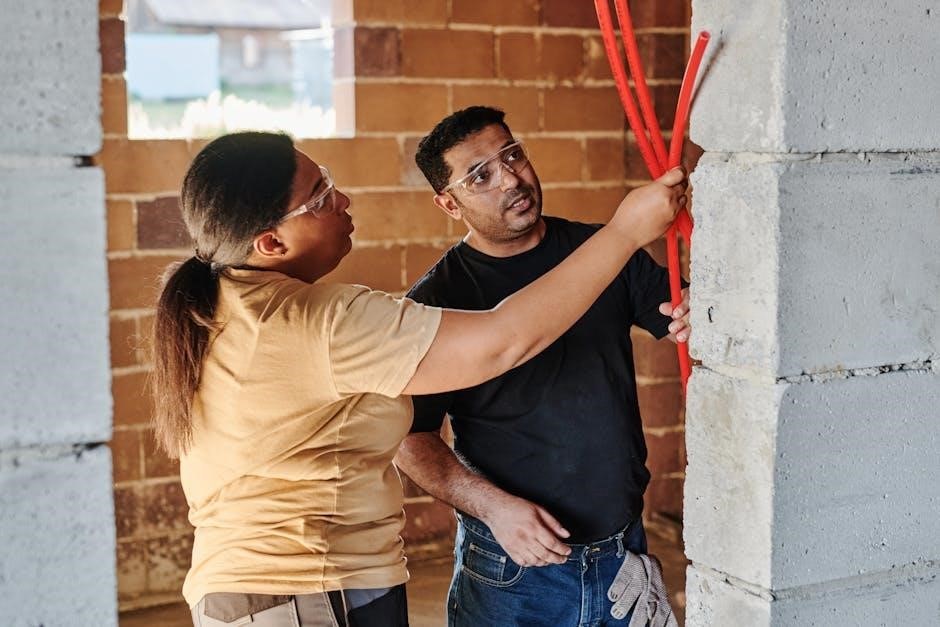porter cable dovetail jig instruction manual
Porter-Cable Dovetail Jig Instruction Manual Overview
This manual provides a comprehensive guide to using your Porter-Cable dovetail jig. It covers everything from initial setup and component identification to creating various dovetail joints. This ensures safe and effective operation.
Understanding the Porter-Cable Dovetail Jig
The Porter-Cable dovetail jig‚ particularly models like the 4212 (possibly equivalent to the DE6212 outside of Russia after Porter-Cable’s acquisition by Black & Decker)‚ is designed for creating strong and aesthetically pleasing dovetail joints. This manual serves as your primary resource for understanding its functionality.
The jig utilizes templates and a router with a guide bushing to create precise dovetails. It allows for both through dovetails (where the joint is visible on both sides) and half-blind dovetails (where the joint is hidden on one side). Proper setup and understanding of the jig’s components are crucial. This manual provides a step-by-step guide.

Safety Precautions
Safety is paramount when operating any power tool. This section outlines general safety rules for power tools and specific precautions for using the dovetail jig to prevent injury and ensure safe operation.
General Safety Rules for Power Tools
Always wear safety glasses to protect your eyes from flying debris. Ear protection is also recommended to reduce the risk of hearing damage‚ especially during prolonged use. Ensure your work area is well-lit and free of clutter to prevent accidents. Keep children and bystanders away from the work area to avoid distractions and potential injuries.
Before using any power tool‚ carefully read and understand the manufacturer’s instructions. Inspect the tool for any damage before each use. Damaged tools should not be used. Use the correct tool for the job and never force a tool to perform a task it was not designed for. Keep a firm grip on the tool and maintain a stable stance. Disconnect the power source before making any adjustments or changing accessories. Be aware of the power cord location and avoid any electrical hazards.
Specific Safety Instructions for Dovetail Jigs
Always ensure the dovetail jig is securely mounted to a stable work surface before operation. Unsecured jigs can move during routing‚ leading to inaccurate cuts and potential injury. Use clamps or screws to firmly attach the jig to your workbench. When routing‚ always feed the router against the cutter’s rotation to prevent kickback. Keep your hands clear of the router bit and the workpiece during operation.
Use appropriate router bits for the desired dovetail joint. Inspect router bits for sharpness and damage before each use. Dull or damaged bits can cause splintering and increase the risk of kickback. Adjust the jig settings carefully‚ following the manufacturer’s instructions‚ to ensure accurate and safe cuts. Wear a dust mask to avoid inhaling wood dust‚ which can be harmful to your respiratory system. After use‚ disconnect the power source and clean the jig to remove any debris.

Components and Setup
This section details the components of the Porter-Cable dovetail jig and provides step-by-step instructions for assembly. Correct setup is crucial for achieving accurate and consistent dovetail joints.
Identifying Jig Components
Before you begin‚ familiarize yourself with all the components of your Porter-Cable dovetail jig. This includes the main jig body‚ which houses the clamping mechanism and provides a stable base for routing. Identify the templates‚ which dictate the shape and spacing of the dovetails‚ and the template guide bushing‚ which ensures accurate routing along the template edges.
Also‚ locate the clamping bars‚ used to secure your workpiece firmly in place‚ and the adjustable stops‚ which control the depth of cut. Understand the function of each component to ensure proper assembly and operation. Refer to the parts diagram included in this manual for a detailed visual reference. Correct identification will streamline the setup process and minimize errors during joint creation.
Assembling the Jig
Proper assembly of your Porter-Cable dovetail jig is crucial for accurate and safe operation. Begin by attaching the template to the jig body‚ ensuring it’s securely fastened with the provided screws. Next‚ install the clamping bars‚ adjusting them to accommodate the thickness of your workpiece. Ensure they move smoothly and lock firmly in place.
Refer to the assembly diagram for the correct orientation of each component. Pay close attention to the alignment of the template guide bushing with the template. Tighten all screws and bolts securely‚ but avoid over-tightening‚ which could damage the jig. Double-check all connections before proceeding to the next step. A correctly assembled jig will provide a stable and reliable platform for creating precise dovetail joints.
Mounting the Jig Securely
Securing the Porter-Cable dovetail jig to a stable work surface is paramount for achieving accurate and consistent dovetail joints. Choose a sturdy workbench or table that can withstand the vibrations of the router. Use clamps to firmly attach the jig to the work surface‚ ensuring it doesn’t move or shift during operation. Consider using non-slip pads beneath the jig to further enhance stability.
If your workbench has pre-drilled holes‚ you may be able to bolt the jig directly to the surface. Ensure the bolts are properly sized and tightened securely. Before beginning any routing‚ double-check that the jig is firmly mounted and cannot move. A wobbly or unstable jig will compromise the accuracy of your dovetail joints and could potentially lead to dangerous situations.
Dovetail Joint Creation
This section details the process of creating dovetail joints using your Porter-Cable jig. It covers setups for both through and half-blind dovetails‚ ensuring accurate and strong connections.
Setting Up for Through Dovetails
Begin by selecting the appropriate template for through dovetails. Ensure the template is securely fastened to the jig frame. Adjust the jig to accommodate the thickness of your workpiece. Precise measurements are crucial for achieving a snug fit.
Next‚ determine the desired spacing and depth of the dovetails. Use the jig’s adjustable stops to set these parameters. Double-check all settings before proceeding. Inaccurate settings can lead to misaligned joints or weak connections. It is important to use a router with a 7/16-inch guide bushing.
Finally‚ secure the workpieces firmly against the jig. Use clamps to prevent movement during routing. This will ensure consistent and accurate dovetails. Verify the router bit is properly installed and set to the correct depth.
Setting Up for Half-Blind Dovetails
To set up for half-blind dovetails‚ begin by installing the correct template for this joint type. Align the template precisely according to the jig’s instructions. Securely fasten the template to the jig frame.
Next‚ adjust the jig to match the thickness of your drawer front or workpiece. The depth setting is crucial for half-blind dovetails. It determines how far the joint extends into the drawer front. Use the jig’s adjustable stops to set the depth accurately.
Also‚ ensure that the tail board and pin board are flush against the jig. Use clamps to hold the workpieces securely. Double-check all measurements and settings before routing. A precise setup is essential for achieving clean‚ professional-looking half-blind dovetails.
Routing the Dovetails
With the jig properly set up and the workpieces secured‚ begin routing the dovetails. Ensure your router is equipped with the correct bit and guide bushing for your jig. Maintain a steady‚ controlled motion as you move the router along the template.
Follow the template openings closely to create the dovetail shapes. Avoid applying excessive pressure‚ which can lead to inaccuracies or tear-out. Make multiple passes if necessary‚ especially when working with harder woods. This prevents the router from bogging down and ensures a cleaner cut.
Also‚ pay close attention to the router’s direction of travel. Routing against the grain can cause splintering. After completing the routing‚ carefully inspect the dovetails. Remove any remaining waste material with a chisel or knife for a perfect fit.

Adjustments and Troubleshooting
Achieving perfect dovetail joints often requires fine-tuning. This section covers adjusting the jig for tight or loose fits. Furthermore‚ it also provides solutions for common issues encountered during dovetail joint creation.
Adjusting for Tight or Loose Joints
Achieving perfectly fitting dovetail joints is crucial for both the strength and aesthetic appeal of your woodworking projects. If your dovetails are too tight‚ they may be difficult to assemble without damaging the wood. Conversely‚ loose dovetails will compromise the joint’s integrity.
The Porter-Cable dovetail jig allows for precise adjustments to address these issues. Typically‚ adjustments involve altering the router bit depth or the position of the template guide bushing in relation to the template. Experiment with small increments to find the optimal setting. For tight joints‚ slightly reduce the router bit depth or move the template guide bushing closer to the template. Conversely‚ for loose joints‚ increase the router bit depth or move the template guide bushing further away from the template. Remember to test your adjustments on scrap wood before committing to your final project pieces.
Troubleshooting Common Issues
Even with careful setup‚ you might encounter issues while using your dovetail jig. One common problem is tear-out‚ where wood fibers splinter during routing. To minimize tear-out‚ use sharp router bits‚ make climb cuts in problematic areas‚ or try scoring the wood fibers before routing. Another issue is inconsistent dovetail sizing.
Ensure your jig is securely mounted‚ and the workpiece is firmly clamped. Double-check your router bit depth and template guide bushing alignment. If you notice excessive vibration‚ inspect your router bit for damage or imbalance. Always test your setup on scrap wood before committing to your final project. If problems persist‚ consult online forums or woodworking communities for solutions. Remember safety first‚ and disconnect the power tool before making adjustments or inspections.

Maintenance and Care
Proper maintenance ensures your dovetail jig’s longevity and accuracy. Regular cleaning prevents dust buildup‚ while proper storage protects it from damage. Following these steps keeps your jig in top condition.
Cleaning and Storage
To maintain optimal performance of your Porter-Cable dovetail jig‚ regular cleaning is essential. After each use‚ thoroughly remove sawdust and debris from all jig components. Use a soft brush or compressed air to dislodge particles from hard-to-reach areas. Avoid using harsh chemicals or solvents‚ as they may damage the jig’s surface or markings.
For storage‚ disassemble the jig if practical and store the components in a dry‚ protected environment. This prevents rust and corrosion‚ especially in humid climates. Consider using a dedicated storage case to keep all parts organized and prevent loss. Ensure the jig is stored flat to avoid warping or distortion. Regularly inspect the jig for any signs of damage and address them promptly to ensure its continued accuracy and functionality.
